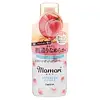What's inside
What's inside
 Key Ingredients
Key Ingredients

 Benefits
Benefits

 Concerns
Concerns

 Ingredients Side-by-side
Ingredients Side-by-side

Water
Skin ConditioningPropylene Glycol
HumectantDimethicone
EmollientMyristyl Alcohol
EmollientButylene Glycol
HumectantAlcohol Denat.
AntimicrobialEthylhexylglycerin
Skin ConditioningGamma-Docosalactone
Skin ConditioningGlycerin
HumectantSteartrimonium Chloride
PreservativeCaprylic/Capric Triglyceride
MaskingHydroxyethylcellulose
Emulsion StabilisingPhenoxyethanol
PreservativeBehentrimonium Chloride
PreservativePrunus Persica Fruit Extract
AbrasiveDisodium EDTA
Aroma
Water, Propylene Glycol, Dimethicone, Myristyl Alcohol, Butylene Glycol, Alcohol Denat., Ethylhexylglycerin, Gamma-Docosalactone, Glycerin, Steartrimonium Chloride, Caprylic/Capric Triglyceride, Hydroxyethylcellulose, Phenoxyethanol, Behentrimonium Chloride, Prunus Persica Fruit Extract, Disodium EDTA, Aroma
Water
Skin ConditioningDimethicone
EmollientIsopentyldiol
HumectantCetyl Alcohol
EmollientBehentrimonium Chloride
PreservativeStearyl Alcohol
EmollientDimethiconol
EmollientPEG-12 Dimethicone
Skin ConditioningHydroxyacetophenone
AntioxidantCetrimonium Chloride
AntimicrobialHydroxypropyl Starch Phosphate
Isopropyl Alcohol
SolventSodium Benzoate
MaskingParfum
MaskingMyristyl Alcohol
EmollientDimethicone/Vinyl Dimethicone Crosspolymer
Skin ConditioningSynthetic Fluorphlogopite
Lauryl Alcohol
EmollientEthylhexylglycerin
Skin ConditioningDisodium EDTA
Titanium Dioxide
Cosmetic ColorantEclipta Prostrata Extract
Skin ConditioningMelia Azadirachta Leaf Extract
Skin ConditioningSodium Chloride
MaskingSea Salt
AbrasivePolysorbate 20
EmulsifyingButylene Glycol
HumectantPearl Extract
AntioxidantMoringa Oleifera Seed Oil
Emollient1,2-Hexanediol
Skin ConditioningPropanediol
SolventHydrolyzed Collagen
EmollientChitosan
Tulipa Gesneriana Flower Extract
Skin ConditioningHydrolyzed Silk
HumectantHydrolyzed Elastin
EmollientHydrolyzed Corn Protein
Skin ConditioningHydrolyzed Keratin
HumectantHydrolyzed Soy Protein
HumectantBenzyl Glycol
SolventHydrolyzed Glycosaminoglycans
HumectantGlycerin
HumectantSodium Hyaluronate
HumectantSodium Hyaluronate Crosspolymer
HumectantElastin
Skin ConditioningCaprylyl Glycol
EmollientKeratin
Skin ConditioningCollagen Extract
Skin ConditioningHydrolyzed Hyaluronic Acid
HumectantStellaria Media Extract
Skin ConditioningHydroxypropyltrimonium Hyaluronate
Gelatin
Sodium Soy Hydrolyzed Collagen
Soluble Collagen
HumectantZinc Hydrolyzed Collagen
Skin ConditioningCollagen
MoisturisingCollagen Amino Acids
MoisturisingHyaluronic Acid
HumectantSodium Acetylated Hyaluronate
HumectantCitronellol
PerfumingGeraniol
PerfumingLinalool
PerfumingWater, Dimethicone, Isopentyldiol, Cetyl Alcohol, Behentrimonium Chloride, Stearyl Alcohol, Dimethiconol, PEG-12 Dimethicone, Hydroxyacetophenone, Cetrimonium Chloride, Hydroxypropyl Starch Phosphate, Isopropyl Alcohol, Sodium Benzoate, Parfum, Myristyl Alcohol, Dimethicone/Vinyl Dimethicone Crosspolymer, Synthetic Fluorphlogopite, Lauryl Alcohol, Ethylhexylglycerin, Disodium EDTA, Titanium Dioxide, Eclipta Prostrata Extract, Melia Azadirachta Leaf Extract, Sodium Chloride, Sea Salt, Polysorbate 20, Butylene Glycol, Pearl Extract, Moringa Oleifera Seed Oil, 1,2-Hexanediol, Propanediol, Hydrolyzed Collagen, Chitosan, Tulipa Gesneriana Flower Extract, Hydrolyzed Silk, Hydrolyzed Elastin, Hydrolyzed Corn Protein, Hydrolyzed Keratin, Hydrolyzed Soy Protein, Benzyl Glycol, Hydrolyzed Glycosaminoglycans, Glycerin, Sodium Hyaluronate, Sodium Hyaluronate Crosspolymer, Elastin, Caprylyl Glycol, Keratin, Collagen Extract, Hydrolyzed Hyaluronic Acid, Stellaria Media Extract, Hydroxypropyltrimonium Hyaluronate, Gelatin, Sodium Soy Hydrolyzed Collagen, Soluble Collagen, Zinc Hydrolyzed Collagen, Collagen, Collagen Amino Acids, Hyaluronic Acid, Sodium Acetylated Hyaluronate, Citronellol, Geraniol, Linalool
 Reviews
Reviews

Ingredients Explained
These ingredients are found in both products.
Ingredients higher up in an ingredient list are typically present in a larger amount.
This ingredient is a preservative and often used for it's anti-static properties. You'll most likely see this ingredient in hair conditioners.
It does not cause irritation or sensitization in leave-on products at 1-5%.
Butylene Glycol (or BG) is used within cosmetic products for a few different reasons:
Overall, Butylene Glycol is a safe and well-rounded ingredient that works well with other ingredients.
Though this ingredient works well with most skin types, some people with sensitive skin may experience a reaction such as allergic rashes, closed comedones, or itchiness.
Learn more about Butylene GlycolDimethicone is a type of synthetic silicone created from natural materials such as quartz.
What it does:
Dimethicone comes in different viscosities:
Depending on the viscosity, dimethicone has different properties.
Ingredients lists don't always show which type is used, so we recommend reaching out to the brand if you have questions about the viscosity.
This ingredient is unlikely to cause irritation because it does not get absorbed into skin. However, people with silicone allergies should be careful about using this ingredient.
Note: Dimethicone may contribute to pilling. This is because it is not oil or water soluble, so pilling may occur when layered with products. When mixed with heavy oils in a formula, the outcome is also quite greasy.
Learn more about DimethiconeDisodium EDTA plays a role in making products more stable by aiding other preservatives.
It is a chelating agent, meaning it neutralizes metal ions that may be found in a product.
Disodium EDTA is a salt of edetic acid and is found to be safe in cosmetic ingredients.
Learn more about Disodium EDTAEthylhexylglycerin (we can't pronounce this either) is commonly used as a preservative and skin softener. It is derived from glyceryl.
You might see Ethylhexylglycerin often paired with other preservatives such as phenoxyethanol. Ethylhexylglycerin has been found to increase the effectiveness of these other preservatives.
Glycerin is already naturally found in your skin. It helps moisturize and protect your skin.
A study from 2016 found glycerin to be more effective as a humectant than AHAs and hyaluronic acid.
As a humectant, it helps the skin stay hydrated by pulling moisture to your skin. The low molecular weight of glycerin allows it to pull moisture into the deeper layers of your skin.
Hydrated skin improves your skin barrier; Your skin barrier helps protect against irritants and bacteria.
Glycerin has also been found to have antimicrobial and antiviral properties. Due to these properties, glycerin is often used in wound and burn treatments.
In cosmetics, glycerin is usually derived from plants such as soybean or palm. However, it can also be sourced from animals, such as tallow or animal fat.
This ingredient is organic, colorless, odorless, and non-toxic.
Glycerin is the name for this ingredient in American English. British English uses Glycerol/Glycerine.
Learn more about GlycerinMyristyl Alcohol is type of fatty alcohol. It is a white, waxy solid and insoluble in water.
As an emollient, it hydrates the skin by trapping moisture in.
Fatty Alcohols are most often used as an emollient or to thicken a product. They are usually derived from natural fats and oils and therefore do not have the same drying or irritating effect as solvent alcohols.
Learn more about Myristyl AlcoholWater. It's the most common cosmetic ingredient of all. You'll usually see it at the top of ingredient lists, meaning that it makes up the largest part of the product.
So why is it so popular? Water most often acts as a solvent - this means that it helps dissolve other ingredients into the formulation.
You'll also recognize water as that liquid we all need to stay alive. If you see this, drink a glass of water. Stay hydrated!
Learn more about Water